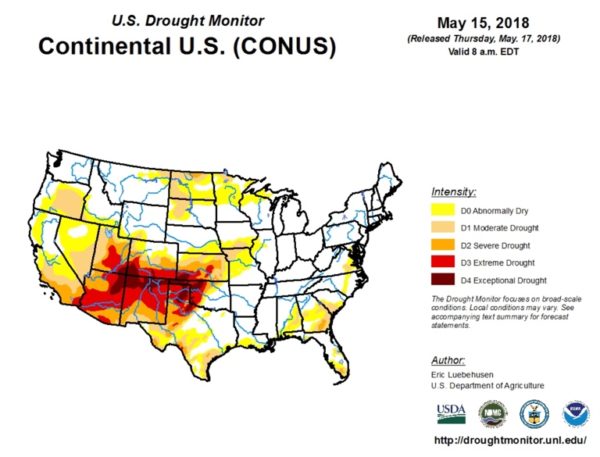One Rain System Won’t Cure a Drought
Discussion: How would you know if you are in a drought? Well, you can observe your local drought monitor website or view what your local Meteorologist has to say. But you can really notice the difference when you step outside and examine your surroundings. First, you’ll witness that the grass is dry and crunchy, the creek in the woods is running low, and the gardens around your neighbor’s house look parched. Your area hasn’t observed an inch of rain in weeks. Finally, a time comes when rain falls steadily throughout the day. You step outside the following day hoping to see an improvement in your neighbor’s garden to only be met with the same depleted look. That rain may have relieved a bit of the arid view, but it is far from making everything lush and green again. After a continued period of time with little to no rain, one rainstorm won’t replenish what had been lost.
Before beginning to see signs of drought, an area will see a decrease of precipitation. Below average amounts of precipitation are usually caused by a shift in weather patterns that drive weather systems away from the area rather than towards it. More likely in the summer, this change in pattern can increase temperatures causing an area to become extremely hot and dry. Dry, hot air increases the evaporation of water from soil and plants leaving the soil to dry up and the plants to wilt. When it is exceptionally dry and it rains, the water immediately evaporates back into the air and rolls off the surface of the soil instead of soaking into the ground. This makes it hard for the soil to regain its moisture level. Due to this, a single heavy downpour will not regenerate a exceptionally dry area. Rain has to happen more frequently in order to allow soil to regain moisture.
There is a considerable number of factors when determining the severity of a drought. Different models and indexes are used to calculate severity including one called the Palmer Hydrological Drought Index (PHDI). This quantifies long-term drought using the water budget, precipitation and temperature data. The more dehydrated an area gets and the less precipitation the area receives, the more negative the PHDI reads.
For example:
- -1 to -1.9 for abnormally dry conditions
- -2 to -2.9 for moderate drought
- -3 to -3.9 for severe drought
- -4 to -4.9 for extreme drought
- -5 or less for exceptional drought
The amount of precipitation needed to improve a drought depends on the time of year, climatology of an area, and drought severity. Climatologists can reverse the calculations of PHDI to estimate the amount of precipitation needed, in inches, to help improve or eliminate a drought. For example, if it were the month of August and your area is in an abnormally dry condition, a trace to 3 inches would be sufficient in improving those conditions. A moderate drought could need 3 to 6 inches, a severe drought may need 6 to 9 inches, and an extreme drought would need 9 to 12 inches. If your area was in an exceptional drought, 12 to 15 inches or more would be needed to make a difference. However, a drought would only improve if that amount of precipitation was going to fall. It may take months to a couple seasons for the weather pattern to cooperate and deliver the needed amounts of precipitation.
More than just one rain system needs to impact the area to replenish what was lost. Rain needs to fall in large quantities and more frequently to make a change in drought conditions. In many cases, weather patterns don’t cooperate, and that area will go longer without seeing rain. This leads to worsening drought conditions and a need for even more rain. Depending on how severe a drought is, it may take multiple rain systems over a course of weeks and months to see an improvement.
To find out more on current or past drought information click here!
© 2018 Meteorologist Alexandria Maynard
AlabamaWX is pleased to partner with the Global Weather and Climate Center team for outstanding posts about our atmosphere. Visit them at https://www.globalweatherclimatecenter.com for more great information!
Category: Partner News Stories
















